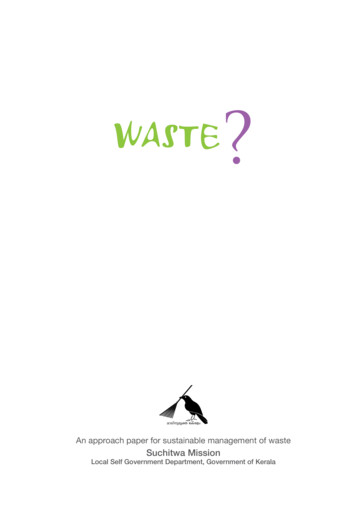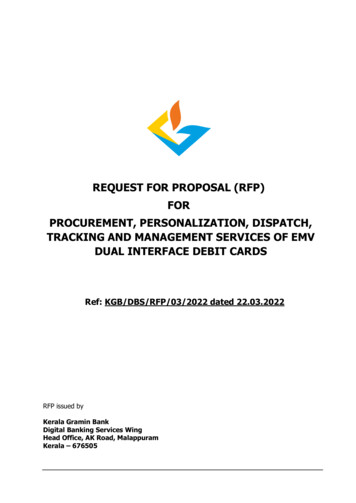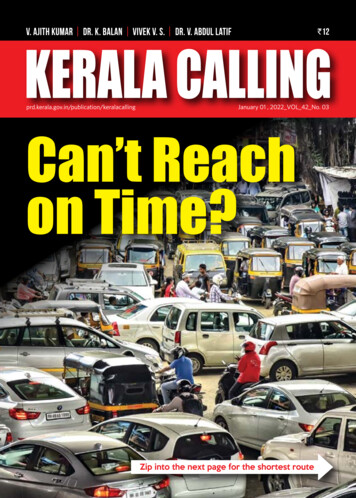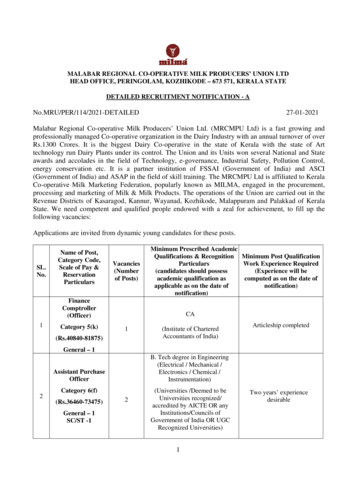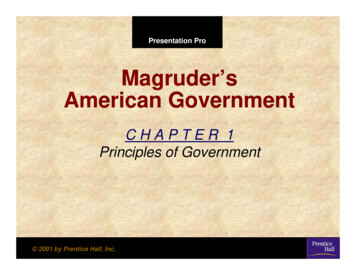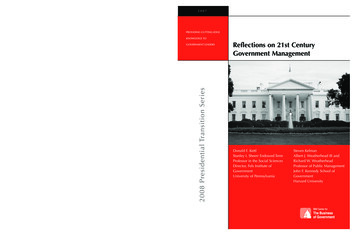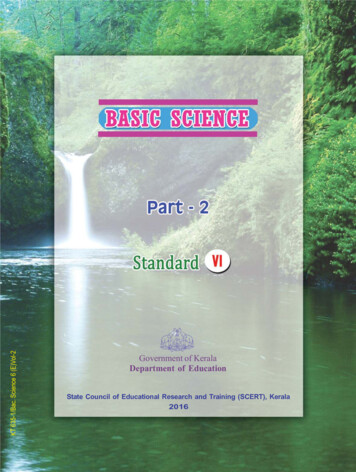
Transcription
Government of KeralaDirectorate of Economics & StatisticsMarch 2017Directorate of Economics and Statistics, 5th Floor, Vikas Bhavan, Thiruvananthapuram–695033. Telephone:04712305318, Fax:0471-2305317
ContributionsDistrict Office (E&S)Deputy DirectorResearch OfficerKollamSri. Z.ShajahanSri.Felix dSri. E.V.PremarajanSmt.Mumtuz Kazim (ADO)Supervision & Data CollectionSupervision - District LevelDeputy Directors & Research OfficersSupervision - Taluk LevelTaluk Statistical Officers & Statistical InspectorsData Collection and data entryStatistical Investigators, Taluk Statistical OfficesOfficers of Survey Design DivisionJoint DirectorSmt.C.S.LathakumariResearch OfficerSri.Kiran.SStatistical Assistant - Grade.ISri.Manoj.K.R.Statistical Assistant - Grade.ISmt.Shibi. C. RSoftware developmentSri.Abhilash K.VResearch Assistant, Computer Division
ContentsExecutive Summary1-7Chapter-1Introduction9-14Chapter-2Some basic characteristics of the dwellings15-18Chapter-3Housing Status19-28Chapter-4Housing Conditions: Major facilities for ised Deprivation47-48Chapter-7Facilities and Availability of Major Amenities49-50Chapter-8Observations for LIFE project51-56Chapter-9Policy Context57-61Appendix -IDetailed TablesT1-T96
Table IndexTable No. Title11.11.2Dwelling CharacteristicsPercentage distribution of type of ration card possessedNumber of families living in the houses for each type of ration cardpossessedPageNumberT.1-T.12T.3T.41.3Percentage distribution of religion for each social groupT.51.4Percentage of houses having at least one active fishermanT.61.5Percentage of families residing in fisherman housesT.71.6Percentage distribution of families according to number ofmembers in the fisherman housesT.71.7Percentage distribution of distance of sea from the houseshaving active fisherman in the sea shore regionT.81.8Percentage distribution of housing statusT.81.9Percentage distribution of type of buildingT.91.10Natural Region wise average living area (in sqr.ft.)T.91.11Percentage of houses having girls in the age group 0-15 years foreach social group1.12Number and percentage of permanently locked housesT.11-T.12Status of Houses constructed under HousingSchemesT.13-T.422T.102.1Number of households living per 100 housesT.152.2Percentage distribution of families by type of household foreach household social groupT.16
Table No. TitlePageNumber2.3Percentage distribution of families by status of ownership orconstruction of any house for each household social groupT.172.4Percentage distribution Status of House for each ration card typeT.182.5Percentage distribution of Status of house according to number ofmembers in the houseT.192.6Percentage distribution of status of house of fishermen familiesT.202.7Percentage distribution of houseless families for each rations cardtypeT.212.8Percentage distribution of houseless families according to numberof members in the houseT.222.9Percentage distribution of houseless fishermen familiesT.232.10Percentage distribution of families by status of assistance fromany housing scheme for each household social groupT.242.11Percentage distribution of families who were provided landalong with housing scheme assistance for each householdsocial groupT.252.12Percentage distribution of present status of house underhousing scheme for each household social groupT.262.13Percentage distribution of present status of house constructedwith assistance from housing schemeT.272.14A-2.14C Percentage distribution of Reason for incompletion of thehouse constructed with assistance2.15A-2.15BPercentage distribution of Reason for incompletion of the fishermenhouse constructed with assistanceT.28-T.30T.31-T.322.16Percentage distribution of constructions used locally availableresources and adopted low cost building methodsT.332.17Percentage distribution of constructions used locally availableresources and adopted low cost building methodsT.34
Table No. TitlePageNumber2.18Percentage distribution of constructions by fishermen families whoused locally available resources and adopted low cost buildingmethodsT.352.19Percentage distribution of financial status after construction ofthe houseT.362.20Percentage distribution of financial status after construction of T.37-T.38the house2.21Percentage of houseless families over total families surveyedand sample number of houseless families identifiedT.392.22Percentage of houseless families having land and houselessand landless familiesT.402.23Percentage distribution of area of land possessed by houselessfamilies having own landT.413Major facilities for LivingT.43-T.783.1Percentage distribution of houses having only one room for eachsocial groupT.453.2Percentage distribution of women only houses having only oneroom for each social groupT.453.3Percentage distribution of houses by facility of bathroom for eachsocial groupT.463.4Percentage distribution of houses having access to bathroomT.473.5Percentage distribution of fisherman houses having facility ofbathroomT.483.6Percentage distribution of fisherman houses having access tobathroomT.483.7Percentage distribution of distance of the dwelling from the bathingplaceT.493.8Percentage distribution of distance of the fisherman houses from thebathing placeT.49
Table No. TitlePageNumberPercentage distribution of houses by use of latrineT.503.10Percentage distribution of reason for not using latrineT.513.11Percentage of fisherman houses by use of latrineT.523.12Percentage of couples having separate room over no of couplessurveyedT.533.13Percentage of aged persons having separate room over no of agedpersonsT.533.14Percentage distribution of houses having aged persons for eachration card typeT.543.15Percentage distribution of women only houses having aged personsfor each ration card typeT.543.16Percentage distribution of type of kitchenT.543.17Percentage distribution of houses by first priority of usage of fuelT.553.18Percentage distribution of houses by second priority of usage of fuelT.563.19Percentage distribution of houses by type of floorT.573.20Percentage distribution of houses by type of wallT.583.21Percentage distribution of houses by type of roofT.593.22Percentage of fisherman houses by type of floor, wall and roofT.603.23Percentage distribution of houses by availability of doors for allroomsT.613.24Percentage distribution of houses by availability of proper doors forbathroomsT.623.25Percentage distribution of houses by availability of strong front &back doorsT.633.9
Table No. TitlePageNumber3.26Percentage distribution of houses by availability of doors for allwindowsT.643.27Percentage distribution of houses by availability of courtyard forchildren for playingT.653.28Percentage of women only houses by privacy and securityT.663.29Percentage of fisherman houses by privacy and securityT.663.30Percentage of fisherman houses by status of proper doors forbathroomsT.673.31Percentage of fisherman houses by status of courtyardT.673.32Percentage distribution of houses by major source of drinking waterfor each household social groupT.683.33Proportion of houses getting sufficient drinking water from themajor source during the different months of the year for eachhousehold social groupT.693.34Percentage of fisherman houses by principal source of drinkingwaterT.703.35Percentage of fisherman houses by availability of sufficient drinkingwater from the principal source of drinking waterT.703.36A-3.36CPercentage distribution of houses by distance to the source ofdrinking waterT.71-T.733.37Percentage of fisherman houses by distance from house to theprincipal source of drinking waterT.743.38Percentage distribution of houses by the facility of electricity foreach household social groupT.753.39Percentage distribution of houses by the facility of Proper lightingsto children and aged for each household social groupT.763.40Percentage of fisherman houses by status of electricityT.774EducationT.79-T.84
Table No. TitlePageNumber4.1Percentage distribution of gender of members in the age group 5-25years for each social groupT.814.2Percentage distribution educational level of persons in the agegroup of 5-25 years, who never attended or currently not pursuingeducation for each household social groupT.824.3Percentage distribution of students in the age group 5-25 years bystatus of having separate study room for each social groupT.834.4Percentage distribution of students in the age group 5-25 years bystatus of having chair & book shelf for each social groupT.8455.1-5.20Facility and Availability of major AmenitiesT.85-T.96Percentage distribution of Distance of the house to the nearestfacility, availability of some amenitiesT.87-T.96
Executive SummaryI.Human settlements problems are of a multidimensional nature. They differfrom individual to individual, rural to urban, and obviously from country tocountry both in terms of quantity and quality. The poor people in rural areawith limited income and know-how construct their own houses withavailable resources, as a result in most cases, the quality of housing ismiserable with insufficient basic services, unhygienic surroundings, lack ofaccess to safe water and proper sanitation. In Kerala the housing issues aremore qualitative than quantitative.II.Compared to the other states in India Kerala hold a better situation owing tomany Kerala specific development schemes implemented by governmentsstarting from land reforms. For the one lakh houses scheme to the people'splan campaign period Kerala achieved tremendous progress in housing andeven introduced total housing scheme by the local self governments. Unlikein other states, Kerala's people utilised the benefits of governmental housingschemes more effectively. Unfortunately the benefits of state interventions notseems to have reached fully, at least to the people living in rural areasparticularly the tribal areas and in sea-shore.III.As the part of India Strengthening Statistical Project (ISSP) MoSPI, GOIdirected to conduct a survey on housing sector of Kerala with 100% CSS.Accordingly, DES submitted a proposal to government and the same wasapproved vide G.O(Rt)No.417/16/Plg. dated 04/11/2016. Meanwhile, tosolve the housing problems of the poor, Kerala Government has announced anew welfare and ambitious mission in the state. – Kerala LIFE - Here LIFEStands for “Livelihood, Inclusion, Financial Empowerment,”. To providedata support for the LIFE Mission Kerala, the Government directed DES toconduct the housing survey in line with the programme objectives of LIFEmission. Hence, this report.Report on ‘Qualitative and quantitative condition in housing in rural Kerala 2016-17’, DES, Kerala1
IV.The time allowed for the study is only three months i.e., October-December2016. Due to the time constraint the study was limited to three districts viz.,Wayanad, Thrissur and Kollam based on topographical importance i.e., thehighland, the midland and the lowland plain, and the coastal plain. Wayanaddistrict was taken as highland zone to ensure the representation of Tribals.The other two districts, Thrissur is considered for midland region, andKollam district for low land region and coastal zone.V.Of the 177 Panchayaths in the 3 selected districts 38 Grama Panchayaths wereselected in the first stage, and from these local bodies, 136 wards wereselected in the second stage and all the residential houses in these wards weresurveyed in detail. Thus primary data from 57,517 houses were collected andcompiled using an online data entry software.OBSERVATIONS OF THE STUDYi. The data gathered from 57,517 sample houses reveal that 63,551 families areaccommodated in the total surveyed households i.e., 110 households per100 houses. Among the three regions surveyedhighland region has thehighest occupancy ratio of 114 families per 100 houses (91% of the housesare single family occupancy and 9% of the houses are more than one familyoccupancy). (Refer Table – 2.1)ii. Another finding is that 15% of the households are houseless, of which 11%are houseless and landless and 4% are houseless with own land. Regionwise data show that houseless families are high in sea-shore (17.5%) andhighland (17.2%). In midland compared to the other two regions houselessare less (12.4%). (Refer Table – 2.3)iii. The social group wise data shows that houseless families are slightly highamong fishermen (17.8%) compared to SCs (17.7%) and STs (14.7%). (ReferTable – 2.4, 2.6)iv. Of the houses surveyed 5.7% are women only houses. Out of this 6.7% ishouseless (5.2% single woman member only households and 8.4% womenReport on ‘Qualitative and quantitative condition in housing in rural Kerala 2016-17’, DES, Kerala2
only houses with 2 or more members) (Refer Table – 2.5 & Statement-3.5)v. In ST women only houses 5.4% are houseless and for SCs it is 8.3%. Whichmeans in women only houses in respect of houseless SCs out number STs.(Refer Table – 2.5)vi. The data also shows that out of the houses surveyed 3.1% families are singlewoman only houses among them 5.2% are houseless.However in STcategory no single woman only house is found houseless. But for SCCategory it is 6.6%. (Refer Table – 2.5 & Statement-3.5)vii. Out of the total sample families 4.6% do not possess Ration Card amongthem 29% are houseless. On analyzing the houseless families with respectto type of ration card possessed, it is seen that around 11.9% are APL cardholders and 17.8% are BPL card holders. (Statement-3.4)viii. Out of the families without ration card 19.2 % STs, 36.9% SCs, 31.1% OBCsand 24.4% Others are houseless. (Refer Table – 2.4)ix. The status of ST families having APL ration card 15% are houseless and inBPL families houseless are comparatively less (13.7%) . (Refer Table – 2.4)x. In houseless single woman houses among SCs 84.6% are landless. Thecorresponding figure for the fishermen houses it is 86.3% which is higherthan SCs. (Refer Table – 2.8 & 2.9)xi.It is also seen that among the houseless families 71.8% STs, 81.3% SCs.77.7% OBCs, 68.5% Others and 86.3% fishermen families are not havingland. The incidence of landlessness is higher among Fishermen and SCs.(Refer Table – 2.7 & 2.9)xii. Region wise data on houseless families shows that in highland 58.4%, inmidland 71.6%, in lowland 82.4% and in sea-shore 86.5% are landless also.(Refer Table – 2.22)xiii. Among STs 72.1% in highland and 66.7% in midland are landless families.In the case of SCs in highland 73.8%, in midland 78.8%, in lowland 83.2%and in sea-shore 88.7% are also landless families. (Refer Table – 2.22)xiv. The data on area of land possessed by houseless families shows that 9.2%households in highland , 19% in midland, 19.6% in lowland and 33.6% inReport on ‘Qualitative and quantitative condition in housing in rural Kerala 2016-17’, DES, Kerala3
sea-shore own less than or equal to 4 cents. (Refer Table – 2.23)xv. Among houseless STs in highland17.5% STs possess land less than or equalto 4 cents but the figure in respect of SCs it is 4.8% in highland. Theseshows in highland SCs have more area of land under their possessionthan STs. (Refer Table – 2.23)xvi. Out of the total 57,517 houses surveyed, 32% of the houses are reported tohave girls in the age group 0–15 years. 23,699 girls in the age group of 0–15years are found in the 18,258 sample houses. (Refer Table – 1.11 & Statement-2.5)xvii. The data reveal that the average living area in houses for all families is 830.7sq.ft. For STs it is 415.7 sq.ft., which is much less compared to the othersocial groups like SCs (563.3 sq.ft.) ,OBCs (849.5 sq.ft.) and Others (922.3sq.ft.). (Refer Table – 1.10)xviii. The data on ration card possessed by houses in highland 51.1% houses areAPL and 34.4% are BPL. In Midland 60.3% APL and 33.9% BPL, in Lowland58.4 APL and 36.6% BPL and in Sea-shore 50.5% APL and 44.9% are BPLhouses. (Refer Table – 1.1)xix. The data on availability of rooms in households shows that 23.2% STs,19.5% SCs and 42.6% OBCs have only one room in their houses. (Refer Table– 3.1)xx. About 9% of the houses in the highland area are not electrified. In respect ofST houses in highland round 32% and 3.1% SC houses in highland arefound not electrified. (Refer Table – 3.38)xxi. Also 15% of the women only houses in the highland region is not electrifiedand the figures for STs it is 26%. In the case of women only houses around3% are not electrified. (Refer Table – 3.38)xxii. In the households surveyed, 19.2% of the houses have aged persons out ofwhich the presence of aged persons in ST houses is 1.8%, in SC houses 7.8% ,in OBC houses 54.2% and in other houses it is 36.3%. (Refer Table – 3.14)xxiii. Around 23% of the women only houses have aged persons and out of whichthe figure is 1.8% in ST families, 10.3% in SC families, 52.4% in OBC familiesand 36.5% in others families. (Refer Table – 3.15)Report on ‘Qualitative and quantitative condition in housing in rural Kerala 2016-17’, DES, Kerala4
xxiv.Another observation is that 27.8% aged people have separate bath attachedrooms in their family , 55.5% have separate not bath attached rooms and16.7 % have no separate room for them. (Refer Table – 3.13)xxv. In security point of view strong doors at least in front and back entries of thebuilding can provide protection to the women and children. The data showsthat many houses are not fitted with strong doors or windows. Out of thetotal houses in highland 25.2%, in midland 17.6%, in lowland 13.4% and insea-shore 17.2% houses have no strong doors. In fishermen families 18.2%houses have no strong doors. (Refer Table – 3.25, 3.29)xxvi. In women only houses 25.8% houses have no doors for all rooms, 12%houses have no proper doors in their bathrooms, 25.1% houses have nostrong doors in front and back of the house and 22% have no shutters forwindows. In ST houses (59.6%) and SC houses (51.3%) have no strong doorsin their houses which show the high deprivation in quality of housing ofthese communities. (Refer Table – 3.28)xxvii. Data regarding the status of Kitchen shows that 67.2% houses have separatekitchen with water tap in their houses. 29.9% houses have kitchen attachedwith house without water tap. 2.8% houses have no separate kitchen intheir house. (Refer Table – 3.16)xxviii. The data on usage of cooking fuel in sample households reveal that amongAPL Ration Card holder families 53% are using LPG and 47% Firewood. InBPL families 65% are using firewood and 35% families uses LPG. InAnthyodaya 83% are using firewood as cooking fuel. (Refer Statement – 4.13)xxix. With respect to access to latrine in highland STs 19% families have nolatrines and 31.5% houses have no bath room of their own. 1.3% familiesare not using their latrines owing to many reasons. In fisherman households1.6% families have no latrine and 2.7% families have no bathroom facilities.(Refer Tables – 3.3, 3.5, 3.9, 3.11)xxx.For the students of highland 68.2% have no separate study room in theirhouses, in the midland 75.1%, in lowland 75.7% and in sea-shore it is 74.7%.(Refer Table – 4.3)Report on ‘Qualitative and quantitative condition in housing in rural Kerala 2016-17’, DES, Kerala5
xxxi. About the availability of chair, table and book shelf for the students, in thehighland 44.5%, in midland43.5%, in lowland 51.6% and in sea-shore 49.5%have no such facilities in their houses. The facilities in houses provided forthe students are not conducive for their education. (Refer Table – 4.4)xxxii. The data regarding status of construction of houses under variousgovernment housing schemes reveal that in highland 41.7%, in midland62.1%, in lowland 34.4% and in sea-shore 29.8% are incomplete due tovarious reasons. In midland region incomplete houses are more in numbercompared to other regions. (Refer Table – 2.12)xxxiii. Of the houses availed government assistance before 1996 period, 4.5% arestill remaining incomplete and for the period 1996-2001 14.9% houses areincomplete. During the period 2002-2007 incomplete houses are 19.6% andduring 2008-2012 the incompletion is 33.2% and after that the incompletionis 27.8%. (Refer Table – 2.14-C)xxxiv. It is seen that in midland locally available resources and low cost buildingmethods were extensively utilised for construction of houses. In midland56.1% houses utilised locally available resources and 19.1% adopted lowcost building technology for housing construction. Among STs compared tothe other social groups use of locally available resources (19.3%) and lowcost methods of housing (7.2%) is not impressive. (Refer Table – 2.16 & 2.17)xxxv. Considering the financial status after the construction of houses it is seenthat 27% families became indebted to various financial agencies in highland.In midland 55.6%, in lowland 64.5% and in sea-shore 42.3% becameindebted. Indebtedness due to house construction with the assistance ofgovernment is high in lowland. (Refer Table – 2.19)xxxvi. In respect of drinking water facilities in 68% of families have wells asprincipal source of drinking water and 25.9% have pipe water. In highland63% families have well water and 26.7% have pipe water. In sea-shore 72.5%are depended on piped water. (Refer Table – 3.32 & Statement – 4.10)xxxvii. The deprivation index computed for five necessities for well being such asReport on ‘Qualitative and quantitative condition in housing in rural Kerala 2016-17’, DES, Kerala6
drinking water, sanitation, electricity, quality of housing and educationalfacilities reveal that incidence of deprivation is significantly high in respectto quality of housing and educational facilities. (Refer Chapter 6)Report on ‘Qualitative and quantitative condition in housing in rural Kerala 2016-17’, DES, Kerala7
Report on ‘Qualitative and quantitative condition in housing in rural Kerala 2016-17’, DES, Kerala8
Chapter 1Introduction1.1 Introduction1.1.1The safety offered by the habitat, people desire to move up for meetingthe demands of identity, status, aesthetics, emotional satisfaction, livelihood supportsystems, linkage with community etc. which make the home an organic entity. Awell designed home would be harmonious with nature and connected with socialInfrastructural facilities, providing an enabling environment. Home sets the patternin the development of the character of the individual as well as the value systemwhich shapes the society. Deprivation of a decent housing, in fact, becomes a threatto social harmony and economic prosperity.1.1.2Housing is also an investment activity and provides impetus toeconomic growth. It has both forward and backward linkages. Because of its forwardand backward linkages, even a small initiative in housing will propel multipliereffect in the economy through the generation of employment and demand. This hasbeen a rowing concern to address various forms of housing deprivation particularlyin developing countries, here with the growing population pressure, meeting thehousing needs of all families is a real challenge.1.2 Background:1.2.1Recognizing the critical importance of human settlement in developingcountries, the Universal Declaration of Human Rights and the InternationalCovenant on Economic, Social and Cultural Rights, have recognized the right tohousing as a human right. It asked the states to take appropriate steps to ensurerealization of this right. India is a signatory to both the Declaration and covenant.Article 19(1) (e) of the Constitution of India states as: “All citizens shall have theright to reside and settle in any part of the territory of India.” This provision isconstrued as a right to residence / home / shelter. In pursuance of this, Indiaembarked on the path of making “housing for all” a reality.1.2.2In Kerala, the rapid urbanization, the service led growth pattern of theReport on ‘Qualitative and quantitative condition in housing in rural Kerala 2016-17’, DES, Kerala9
economy, the high density of population, the inadequate supply-demand dynamicsof the land, vital role of the local bodies consequent to the 73rd and 74thConstitutional amendments, weak regulatory structure in the housing sector, distinctproblems of the marginalized sections of the society, geographic specificity of theregions, growth of the informal labour market, the livelihood concerns, theecological and environmental sensitivity of the development activities etc are someof the major factors calling for designing the housing policy of the State and so itwas announced in 1994 and later modified in 2011.The legislations and initiatives bythe state government after 73rd and 74th Constitutional amendments and therevision of Panchayat Raj, and Municipal Acts conferred the mandate forimplementation of housing schemes to economically weaker sections to the LocalSelf Government Institutions.1.2.3At present, the major State government aided housing schemes for theeconomically weaker sections are the EMS Total Housing Scheme, Tribal HousingScheme, New Suraksha Housing Scheme, schemes of SC & ST departments,Fishermen Housing Scheme, Bhavanasree, Asraya and MN Lakshamveedu PunarNirmana Padhathi. Centrally sponsored housing schemes such as Indira AwasYojana, Valmiki Ambedkar Awas Yojana (VAMBAY), Integrated Housing and SlumDevelopment Project (IHSDP), Basic Services to Urban Poor (BSUP), NationalFishermen Welfare Fund (NFWF), Interest Subsidy scheme for Housing the UrbanPoor (ISHUP), Affordable Housing in Partnership (AHP) etc. are also aimed atproviding financial assistance for constructing houses to the poor and economicallyweaker sections in the State. Jawaharlal Nehru National Urban Renewal Missiontargets, acceleration of supply of land, shelter and infrastructure with specialattention to provision of basic service to urban poor and upgradation of slums. Thenewly introduced scheme of Rajiv Awas Yojana (RAY) also focuses on resolving theemerging needs of poor people in slums due to urbanization. However, a number ofGovernment departments/agencies like Fisheries Department, SC&ST DevelopmentDepartments, Rural Development Department, Revenue Department, Kudumbasree,Local Self Government Institutions, KSHB, Co-operative institutions, NGOs, CBOs,Report on ‘Qualitative and quantitative condition in housing in rural Kerala 2016-17’, DES, Kerala10
Charitable Organisations etc. are also active in providing shelter to the economicallyweaker sections substantially.1.3 Relevance of the Study:1.3.1Many researchers, agencies and institutes studied Kerala’s housingscenario, particularly the qualitative and quantitative shortage in housing and evencritically evaluated the housing schemes but their data varies in many respects dueto many reasons including technical grounds. The common finding was that evenafter governmental interventions the social, economic, and ethnic groups dependingon the primary sector for their livelihood are living in extremely poor quality houses.Their habitats are characterized by overcrowding, lack of basic amenities andfacilities such as drinking water and sanitation. The rich minority in the villageslives, on the other hand, in luxurious houses with all built-in facilities andconveniences comparable to the standards observed in urban centers of advancedmarket economies leading to large inequality.1.3.2The public housing schemes launched by the State government fromtime to time have received wide acceptability among the people to the extensiveawareness programmes of the Government and the literacy level of the population.Nevertheless, data sources reveal that about 2 lakh families are still landless and 5lakh families are houseless(EMS Housing Scheme). According to Census 2011houseless families are only 5759 which is no doubt due to the concept or definition ofFamilies they had adopted. The Socio Economic Caste Census 2011 reports the figureas 2621 families. This mismatch in data highlights the need for a thorough survey onhousing scenario of Kerala. It may also appear paradoxical that the governmentalinterventions in housing for the poor do not yield the desired results in a state likeKerala which is considered as unique model of social development all over theworld. This situation warrants a study on the qualitative and quantitative shortagein Housing in the State and so the present survey was conducted as a pilot and adetailed Housing survey would be proposed latter if the government decides so.Report on ‘Qualitative and quantitative condition in housing in rural Kerala 2016-17’, DES, Kerala11
1.4 ObjectivesThe main objectives of the study were to: Assess the landless and houseless families/households in rural areas. Examine the qualitative and quantitative shortage in Housing. Analyse regional inadequacies disparities, and inequalities in housing. Record the status of houses started construction under various housingschemes or financial support from government or other agencies and alsoto record the reasons for if the status of houses is incomplete, dilapidated,demolished etc. Trace the extent to which the ongoing housing schemes make use of thecapabilities of the rural poor, locally available resources, and cost-effectivetechnologies. Identify the facilities available in houses in general and the facilitiesavailable to women, children and aged people. Discuss the action programmes for solving the housing problems of thepoor in the selected regions within a time frame.1.5 Design of the Study:1.5.1In order to conduct the survey with limited resources and time it wasconfined to three districts viz., Wayanad, Thrissur and Kollam. These districts wereselected based on topographical importance i.e., the physiographic zones: thehighlands, the midlands and the lowland plain, and the coastal plain as the problemof housing differs in many respects depending on the topography of the place. Thedistrict of Wayanad was taken as highland zone which also covers the Tribalpopulation having acute problem of housing. Thrissur district is considered
T.37-T.38 2.21 Percentage of houseless families over total families surveyed and sample number of houseless families identified T.39 2.22 Percentage of houseless families having land and houseless and landless families T.40 2.23 Percentage distribution of area of land possessed by houseless families having own land T.41


